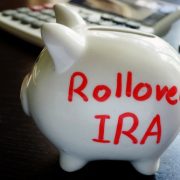Leaving Your Job? Here’s What You Can Do with Your 401(k)
When you leave your employer, you have some decisions to make about what to do with any accumulated retirement balances (401(k).
Whether you quit, get laid off, get fired for cause or retire, your options are the same. But choose carefully, because your decision can have some significant tax ramifications, and affect your long-term financial security.
Your options
Employees who leave their employers have five basic options:
1.) Take the cash.
2.) Do nothing. Leave your money where it is.
3.) Roll the balance over to an IRA.
4.) Roll the balance over to an IRA and then convert it to a Roth IRA.
5.) Roll the balance over into a new employer’s 401(k) plan, a small business solo 401(k) plan or a Self-Directed 401(k) that you would set up if you are in business for yourself.
Let’s take a closer look at each one:
1.) Take the cash. You can have your plan send you a check for all or part of your 401(k). This is usually not recommended if you can avoid it, though, for a number of reasons:
- You will not get the full amount. 401(k) plan administrators are required by law to deduct 20 percent of your withdrawal (called a “distribution) and send it to the IRS to pay anticipated taxes.
- You may have to pay a 10% penalty on the entire withdrawal.
- You will have to pay federal and state income taxes on the amount withdrawn.
- Even though you will receive only 80% of your total balance, you will get charged taxes and penalties on the entire distribution, including the amount that gets sent to the IRS.
- You potentially forego years of tax-advantaged compounding
- You forego the benefits of asset protection. Your creditors cannot access your 401(k) But they can access your money once it’s out of a retirement account.
For these reasons, most planners do not recommend taking a cash distribution from a 401(k), especially when you will have to pay the 10% early withdraw penalty.
2.) Leave it where it is. If your employer allows you to leave your plan in place when you leave the company, you can delay taking a distribution or rolling your plan over.
There are some disadvantages:
- You may have limited investment options. 401(k) menus are usually limited to a set of mutual funds and guaranteed option contracts (GICs) and money markets that are selected as much to protect the plan sponsor from liability as they are for your long-term investment success. You could be limited to mediocre-performing or high-expense mutual funds.
- You have to stop contributing to your 401(k) once you leave the company.
- You will have more accounts to keep track of and manage.
However, leaving money in place may be a reasonable temporary solution while you decide what you want to do going forward. If your plan sponsor does not force you to make a decision right away, you can take your time and do your research before committing to one of the other options.
3.) Roll the balance over to an IRA.
This is one of the two options financial planners most often recommend. With this option, you establish an IRA account with the investment company of your choice. You then have two options:
- Have the 401(k) plan sponsor send you a check. They will deduct 20 percent for taxes. You then have 60 days from receiving the money to deposit your entire 401(k) withdrawal into the new IRA. If you take longer than 60 days, you will generally have to pay the income taxes and applicable penalties.
- A more common solution is to execute a trustee-to-trustee transfer of the 401(k) balance to your IRA custodian or administrator. With this option, the money never enters your hands. There’s no 20% deduction for taxes. The entire amount is transferred directly into your new IRA account. Your IRA company will help you make this happen.
With a qualified 401(k)-to-IRA rollover, there are no taxes to worry about. The money continues to compound, tax-deferred, as it did in your 401(k).
Among the advantages:
- You get far more investment choices with an IRA, including the option to create a Self-Directed IRA. These accounts allow you to take more direct control of your IRA money, so you can choose to invest it in rental real estate, tax liens and investments, a partnership, LLC or S-corporation, or nearly any other investment you can think of.
- You may be able to find better-performing funds, funds with lower expense ratios or both by moving your money out of a 401(k) plan that you don’t control and into an IRA plan that you do.
4.) Roll the balance over to an IRA and then convert it to a Self-Directed Roth IRA
With a Self-Directed Roth IRA, the account generally compounds tax-free, and you can take tax-free withdrawals in retirement, provided you leave the funds in place within your Roth IRA for at least five years. However, Roth IRA contributions are not deductible. You pay your taxes up front – but you get a powerful tax advantage for the long run, in return.
Self-Directed Roth IRAs also do not have required minimum distributions to worry about. If you leave the money alone in a Roth IRA, the account can grow tax-free for as long as you live.
To take advantage of this option, you would do a rollover as in Step 3, and then tell your IRA company to do a Roth conversion. You will have to pay income taxes on any amounts you decide to convert to a Roth.
For best results, use money saved up outside your IRA or other retirement accounts. However, you can use money from within your IRA to pay taxes.
The Roth conversion option is often a great option for younger, upwardly mobile workers, and those who believe that income taxes are likely to go up over time.
Moving retirement income to the “tax-free” column may also enable you to reduce exposure to Social Security Income Taxes or preserve eligibility for means-tested government benefits.
5.) Roll the balance over into a new employer’s 401(k) plan, a small business ‘Solo 401(k)’plan or a Self-Directed 401(k).
You may also roll your old 401(k) balance into a new 401(k). This can be with a new employer’s existing plan, or, if you are self-employed or own your own corporation, you can establish a new small-business retirement account of your own.
You can even set up a Self-Directed Solo 401(k) – an affordable, simplified version of a 401(k) plan designed for companies with just one full-time employee, or for companies operated by married couples.
This option may allow you to set up a 401(k) the way you like it. You can create a 401(k) with a Roth option, for example, or set up your plan to allow for loans.
You can even create a Self-Directed Solo 401(k) plan. These allow for a wider variety of investments, including investments into alternative asset classes.
American IRA, LLC specializes in helping our clients administer Self-Directed IRAs and 401(k)s, as well as other self-directed tax-advantaged accounts.
Interested in learning more about Self-Directed IRAs? Contact American IRA, LLC at 866-7500-IRA (472) for a free consultation. Download our free guides or visit us online at www.AmericanIRA.com.









